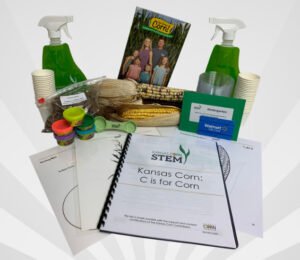Free Classroom Kit
C is for Corn
Grade Level: Kindergarten
 Students will explore the parts of corn, the sounds of the phoneme hard C, and patterns. Students will infer through evidence where corn comes from and what animals might eat corn. Students become scientists during a hands-on lab lesson, discovering similarities and differences of field corn and Indian corn, with beginning development and understanding of inheritance.
Students will explore the parts of corn, the sounds of the phoneme hard C, and patterns. Students will infer through evidence where corn comes from and what animals might eat corn. Students become scientists during a hands-on lab lesson, discovering similarities and differences of field corn and Indian corn, with beginning development and understanding of inheritance.
Quick Links
About Kansas Corn STEM
Investing in Kansas teachers and students is a priority for the Kansas Corn Commission. We are committed to providing materials and training to support STEM education while fostering an understanding of how corn farming and agriculture fit into our daily lives. All K-5 lessons come with a free teacher kit that includes the teaching materials needed for each lesson.
Request MaterialsThis lesson is the work product of the Kansas Corn Commission. Our lessons are written in collaboration with Kansas teachers for use in the classroom. Teachers may copy and share this curriculum. Use of this product for commercial or promotional use is prohibited without express permission of Kansas Corn.
Newsletter Sign Up
Each quarter we release a newsletter written by teachers for teachers. This is an easy way to keep up with what is happening at Kansas Corn STEM.
Subscribe Today!